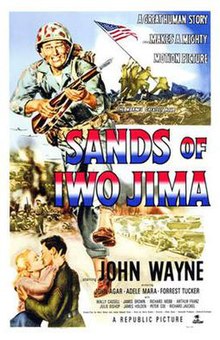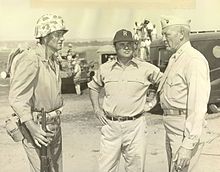Sands of Iwo Jima
| Sands of Iwo Jima | |
|---|---|
 Original film poster | |
| Directed by | Allan Dwan |
| Written by | Harry Brown James Edward Grant |
| Produced by | Edmund Grainger |
| Starring | John Wayne John Agar Forrest Tucker Adele Mara |
| Narrated by | Arthur Franz |
| Cinematography | Reggie Lanning |
| Edited by | Richard L. Van Enger |
| Music by | Victor Young |
| Distributed by | Republic Pictures |
Release date |
|
Running time | 100 minutes |
| Country | United States |
| Language | English |
| Box office | $3.9 million (US/ Canada rentals)[1][2] |
Sands of Iwo Jima is a 1949 war film starring John Wayne that follows a group of United States Marines from training to the Battle of Iwo Jima during World War II. The movie also features John Agar, Adele Mara, and Forrest Tucker, was written by Harry Brown and James Edward Grant, and directed by Allan Dwan. The picture was a Republic Pictures production.
Sands of Iwo Jima was nominated for Academy Awards for Best Actor in a Leading Role (John Wayne), Best Film Editing, Best Sound, Recording (Daniel J. Bloomberg) and Best Writing, Motion Picture Story.[3]
Plot
Tough-as-nails career Marine Sergeant John Stryker (John Wayne) is greatly disliked by the men of his squad, particularly the combat replacements, for the rigorous training he puts them through. He is especially despised by Private Peter Conway (John Agar), the arrogant, college-educated son of an officer, Colonel Sam Conway under whom Stryker served and admired, and Private Al Thomas (Forrest Tucker), who blames him for his demotion.
When Stryker leads his squad in the invasion of Tarawa, the men begin to appreciate his methods, except Conway, who considers him brutal and unfeeling when he apparently abandons a wounded comrade to the enemy. During the battle, Thomas becomes distracted from his mission, and "goofs off" when he goes to get ammunition for two comrades, stopping to savor a cup of coffee. As a result, though he brings back coffee for his squadmates, he returns too late — the two Marines, now out of ammunition, in the interim are shown being overrun; Hellenopolis (Peter Coe) is killed, Bass (James Brown) badly wounded. When Stryker discovers the truth, he forces Thomas into a fistfight. This is seen by a passing officer, but Thomas, to Stryker's surprise, deflects the officer's intention of pressing charges against Stryker for violation of military rules in striking a subordinate by claiming that he was merely being taught judo by his superior. Subsequently, ravaged by his conscience over the fate of his fellow Marines, Thomas breaks down and abjectly apologizes for his dereliction of duty.
Stryker reveals a softer side of his character while on leave in Honolulu. He picks up a bargirl (Julie Bishop) and returns with her to her apartment. He becomes suspicious when he hears somebody in the next room, but upon investigation, finds only a hungry baby boy that his intended paramour is supporting the best way she can. Stryker gives the woman, whose child's father was "gone," some money and departs. The woman had earlier noted that there were "worse ways to make a living than fighting a war," in reference to her current lot in life.
Later, during a training exercise, a recruit drops a live hand grenade. Everybody drops to the ground, except Conway, who is distracted reading a letter from his wife. Stryker knocks him down, saving his life, and then proceeds to bawl him out.
Stryker's squad subsequently fights in the battle for Iwo Jima, witnessing the iconic flag raising on Mount Suribachi. Afterward, while the men are resting during a lull in the fighting, Stryker is killed by a Japanese soldier emerging from a spider hole. The surviving squad members find and read a letter on his person, a missive addressed to his son and expressing things Stryker wanted to say to him, but had never actually managed to.
Cast

- John Wayne as Sgt. John M. Stryker
- John Agar as PFC Peter Conway
- Adele Mara as Allison Bromley
- Forrest Tucker as PFC Al Thomas
- Wally Cassell as PFC Benny Regazzi
- James Brown as PFC Charlie Bass
- Richard Webb as PFC Dan Shipley
- Arthur Franz as Corporal Robert Dunne / Narrator
- Julie Bishop as Mary (the bargirl)
- James Holden as PFC Soames
- Peter Coe as PFC George Hellenopolis
- Richard Jaeckel as PFC Frank Flynn
- William Murphy as PFC Eddie Flynn
- Martin Milner as Pvt. Mike McHugh
- George Tyne as PFC Harris
- Hal Baylor as PFC "Sky" Choynski
Actual Marines
Rene Gagnon, Ira Hayes & John Bradley, the three survivors of the five Marines and one Navy corpsman who raised the second flag on Mount Suribachi during the actual battle, appear briefly in the film just prior to the re-enactment. Hayes was also the subject of a film biography, The Outsider, and Bradley the subject of a book by his son James, Flags of Our Fathers.
Also appearing as themselves are 1st Lt. Harold Schrier, who led the flag-raising patrol on Iwo Jima, Col. David M. Shoup, later Commandant of the Marine Corps and recipient of the Medal of Honor at Tarawa, and Lt. Col. Henry P. "Jim" Crowe, commander of the 2nd Battalion 8th Marines at Tarawa, where he earned the U.S. Navy Cross.[4][5]
Later acknowledgements
This article needs additional citations for verification. (May 2012) |
Compared with most combat films of its time, Sands of Iwo Jima was fairly nuanced in its view of war and military people. Ironically, many references to it in mass media and popular culture depict it as the quintessential "flag-waving" World War II film. This may have less to do with the movie's actual contents than with star John Wayne's later identification with conservative politics.
Several of the actors were re-united in the 1970 western Chisum (1970): John Wayne, John Agar, Forrest Tucker, and Richard Jaeckel.
The 1982 Academy Award nominated comedy short film The Great Cognito makes an implied reference to Sands of Iwo Jima. The only character to be seen onscreen is an entertainment impersonator, who actually changes into the people and events he talks about in his comic patter, using Will Vinton's technique of stop-motion claymation. In the end, while talking of Iwo Jima, Cognito breaks down in tears and leaves the stage, blubbering about how "...John Wayne gets shot."
In the television show King of the Hill (1997–2010), this is the favorite film of Cotton Hill, father of main character Hank Hill. Hank recalls that, during his childhood, his father would travel around Texas searching for showings of this film.
The episode "Call of Silence" (2004) in NCIS's season 2 references the film and a documentary as shared background to Marine history and legacy. The episode shows the NCIS character Timothy McGee watching the documentary To the Shores of Iwo Jima; the character Anthony DiNozzo approaches and, in furtherance of the character's schtick as an avowed and knowledgeable movie buff, begins talking about the theatrical film Sands of Iwo Jima, some scenes of which were taken from the documentary.
The Southern rock band Drive-By Truckers have a song titled "The Sands of Iwo Jima" on their 2004 album The Dirty South. It is sung from the perspective of a young boy who has been exposed to World War 2 through old John Wayne movies. He asks his great-uncle, a World War II veteran, if The Sands of Iwo Jima represents the war properly; the old man smiles, shakes his head and responds, "I never saw John Wayne on the sands of Iwo Jima." This may be a reference to the fact that Wayne, despite his many roles as a member of the armed forces, never actually served in the military.
Idiom
The first recorded use of the phrase "lock and load" is in this film: twice as a metaphor for "get ready to fight" and once as a humorous invitation to drink alcohol (get loaded).[6] As a period term, it similarly appears in the more recent film Saving Private Ryan. Although the original use and implied meaning may be disputed, it typically described preparations for charging the M1 Garand semi-automatic rifle[7] by first locking the bolt back by pulling the charging handle rearward and then loading an 8-round en bloc clip into the now open magazine.
See also
References
- ^ 'The Top Box Office Hits of 1950', Variety, January 3, 1951
- ^ "All-Time Top Grossers", Variety, 8 January 1964 p 69
- ^ "The 22nd Academy Awards (1950) Nominees and Winners". oscars.org. Retrieved 2011-08-18.
- ^ T. M. P. (1949-12-31). "Movie Review - Sands of Iwo Jima - At the Mayfair". The New York Times. Retrieved 2014-02-16.
- ^ Suid, Lawrence H. (2002). Guts & Glory: The Making of the American Military Image in Film. University Press of Kentucky. p. 121. ISBN 0813122252. Retrieved 2014-02-16.
- ^ [1]
- ^ http://www.sproe.com/l/lock-and-load.html
External links
- 1949 films
- Wikipedia neutral point of view disputes from May 2012
- 1940s war films
- American films
- American war films
- English-language films
- American black-and-white films
- Battle of Iwo Jima films
- Pacific War films
- Films set in Kiribati
- Republic Pictures films
- Films directed by Allan Dwan
- Screenplays by Harry Brown (writer)
- Film scores by Victor Young
- United States Marine Corps in popular culture
